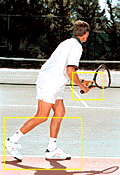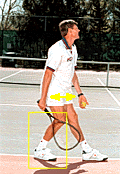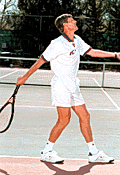|
TennisOne Lessons
|
 |
 |
 |
The Address
In the first photo below, I am surveying the court and planning how the point will unfold. I've brought my hands up together, most of my weight is on front foot, and I am in a balanced, poised position. I make a consistent ritual of this startup pose, and I always take a momentary pause before I launch into my service delivery.
After having brought my hands (and racquet) up together, in the second photo (middle) my hands have separated as my arms swing down together. I'm following the classic "hands up and down together" pattern, and this is one of the keys to establishing my serving rhythm. Notice that my eyes are moving up to the target area. The target area is not where I hope my serve is going to land (in my opponent's service box), but the exact spot I want to place my toss (note that I'm not watching the ball in my left hand). As opposed to the target area for the flat serve, which is out in front, for the kick serve, the target area directly above or even behind the head. In the third photo I'm continuing to focus on my target area as I begin to get my shoulders in alignment for the serve.
Poised for the hit
You can easily imagine a freeze frame of Becker's kick serve in the first photo below. My left arm is pointed up at my vertical target area, and because of this type of toss, my knee bend is deep and my torso is somewhat tilted back. The torso and shoulders have coiled, and the right elbow is low. Vic Braden once said that for a big serve, "fire the extensors, baby." The only extensor muscles available for the serve are the quadriceps and the triceps. As I am aligned for the serve, notice that my elbow is bent as are my knees. This sets up the extension of my quads and triceps as they move into a strong, swift, upward hitting action.
The second photo shows my leg extension and the beginning of my elbow and tricep extension. Note how high the elbow is compared to the first photo. This adds to my upward acceleration. Finally in the third photo, as I begin to turn into the serve, notice the racquet frame on edge. The final part of the serve is a sharp snap of the racquet into the ball. When the racquet is on edge, I'm able to save this snap for the last moment. Through all three photos I have held my head up and my eyes are totally fixed on the ball.
The hit and moving into the net
There are a number of key positions worth describing directly after the moment of contact on the serve. In the first photo below notice that I'm well extended, with my right shoulder higher than the left. Serving tall means going up for the ball, and when done properly the server won't be bent at the waist, but rather in this more vertical position. Notice how the wrist and racquet are turned out. When compared to the photo of the racquet on edge in the previous sequence, this photo shows the range of motion as well as the power of a sharp snap of the racquet at impact.The final two photos show a full shoulder turn into the hit, which propels me quickly to the net. My high, kicking serve gives me the time to get to the net, and the forward rotation of my shoulders definitely enables me to get to a quick, running start. One final comment. Servers can land either on their left or right foot after the hit, and we can find examples of top professionals doing both. I prefer landing on my left foot. Also notice that I've landed in a slightly off-balanced forward motion. This adds even more speed to my net rushing attack. So if you haven't mastered it yet, work on developing a topspin serve. It will give you a nice margin of safety for clearing the net while still maintaining the aggressive, attacking you will soon be famous for.
